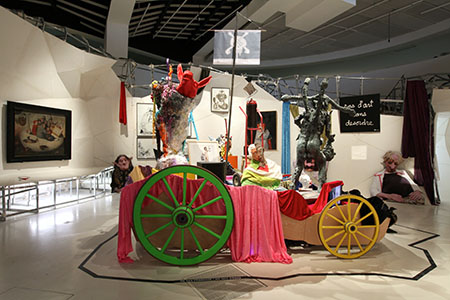Les Maîtres du Désordre

The experience of ‘Maîtres du Désordre’ (Masters of Chaos) was that of an upward fall. The exhibition, a curiosity cabinet of cultural artefacts from the museum’s collection – from India to Africa, from the ancient Greeks to the Inuits, punctuated by works of modern and contemporary art relevant to ‘a life out of sync’ – transported you down though harrowing visions of the forces of chaos in the world, then through an array of rituals for mastering this pandemonium, before navigating towards forms of catharsis. This eclectic phrasing walked a fine line between the poignant and the ominous as you witnessed humankind, throughout the ages, attempt – at any cost – to bring order to life through magic, spirituality and religion, in the form of ritual objects, masks, costumes, and even altars. When we have occasionally succeeded, it is never for long because the next upward fall is always about to commence. In this, the exhibition’s curator, Jean de Loisy, vividly succeeded in orchestrating the experience of slipping between human innocence and our attempted reconciliation with powers greater than us – whether nature, gods or spirits. He was aided by the magnificently discordant and jagged exhibition design conceived by Jakob+MacFarlane. And it mustn’t go unsaid that this largely historical exhibition constantly echoed profound questions for the here and now: What role shall we ascribe appeasement with evil and mayhem? What does it mean in the secular West to maintain faith in what others call superstition? In broad strokes and acute detail, ‘Les Maîtres du Désordre’ mapped the anthropology of consciousness.
Borrowing the title of his exhibition from the subtitle of Bertrand Hell’s masterful Possession et chamanisme (Possession and Shamanism, 1999), De Loisy naturally focused on sacred and profane artefacts used in numerous shamanistic rituals. Amidst many others, represented were the rites of the Native American medicine man, the initiation ritual practiced by the Evenks in Russia (relayed by means of an astonishing initiation costume), a Haniwa shaman figure from Japan and, from ancient Greece, a carved bas-relief of Orpheus, reminding us that he was the proto-shaman whose divine music could enchant all living creatures, including stones. Sitting comfortably amongst these exceptional shamanistic archetypes was a work by Joseph Beuys: his 1965 masterpiece How to Explain Pictures to a Dead Hare. Shamanism gains its power not only from mythological narratives but from true belief. The shaman is a shape-shifter, an ambivalent character who moves between this world and others, who will descend into barbarity only to reemerge offering alleviation from chaos and paths to reconciliation with greater powers. Perhaps no other artist from the last century believed in his own shamanistic dominion more deeply than Beuys, making him a rich case study for De Loisy’s aspiration to cast shamanism as the legacy of certain modern and contemporary artists.
Beuys was shot down in the Crimea, flying in a Stuka dive-bomber on 16 March 1944. From there his legend begins. As he recounted it, after the crash, teetering between life and death, he was revived by a nomadic Tatar tribe using the supernatural curative properties of fat and felt. In fact, Beuys was found conscious by a German rescue team, and released from a military hospital on 7 April to return to duty. There were no Tatars in the area. Beuys framed his identity as the shaman-artist who descended into war and savagery only to reemerge justly believing in ritualistic healing powers. Notably, the otherwise extraordinary catalogue for ‘Les Maîtres du Désordre’ unblinkingly propagates Beuys’s origin myth, which makes one wonder why, because there is no doubt that Beuys faithfully believed he transgressed the boundary of art, reconciling humankind with its lost spiritual life through his work. Beuys was undoubtedly a contemporary shaman, even if the Tatars hadn’t saved him, and this should have been De Loisy’s point, full stop.
In ‘Mastering Chaos’, the middle section of the exhibition, 12 ritual paths designed to supplant chaos with the order of marginal sects were explored, including the ‘Intercessor’, the ‘Psychonaut’, ‘Exorcism’ and ‘Sacred Clowns’. Each sect was represented by ritual artefacts – the Intercessor by a Nganga ceremonial costume from Congo dated before 1889 – or modern works of art (Picasso’s 1927 Arlequin represented the sacred clown). The creepiest passage of all was ‘Épicerie des Forces’ (A Power Store), presenting fetishized ritual objects emerging from the dark side of human cruelty, spell-casting, disease and death, fashioned by initiates as instruments of force imbued with the power to defeat chaos. One dramatic object was the figure of the crucified Christ, armless and bound with cord to a fragment of his cross, which was used in witchcraft rituals in 19th-century Austria. To defeat chaos with chaos is a paradox. On the other hand, so too is an upward fall, at least as Hegel expressed it as Christian theology. Humankind must first fall in order to be saved, as any good shaman knows.
















